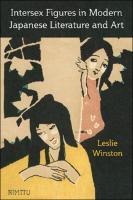
| Judul | Intersex Figures in Modern Japanese Literature and Art / Leslie Winston |
| Pengarang | Winston, Leslie |
| Penerbitan | Michigan : University of Michigan Press, 2025 |
| Deskripsi Fisik | 186 hlm :ill |
| ISBN | 9780472905355 |
| Subjek | Japanese literature — History and criticism |
| Abstrak | Intersex Figures in Modern Japanese Literature and Art explores the history of intersex or futanari figures in modern Japanese literature and culture to examine the provocative discourses that defied a sexual regime as the modern nation-state of Japan advanced its national and imperial designs. As sexologists and medical practitioners continued reinforcing categories of “male” and “female,” “normal” and “pathological,” intersex literary figures garnered attention because the perceived subject was expected to be male or female—any variation was unintelligible. Many of the same century-old tropes and societal attitudes of needing to “cure” intersex persist. At the same time the 1991 novel Ringu by Suzuki K?ji testifies to a denial of futanari subjectivity, while the 1998 Japanese horror film (Ringu) and its 2002 American remake (The Ring) erase intersex all together. Winston interrogates how the trope of the futanari is deployed for pragmatic or aesthetic purposes, thereby complicating the trajectory of the dominant sexological ideology of the time. Winston reads the figurative futanari in the works of Shimizu Shikin, Tanizaki Jun’ichir?, and Takabatake Kash?, and reveals how the artists’ different approaches to the futanari served their agendas and expressed views that challenged the dominant discourse on intersex. |
| Bentuk Karya | Tidak ada kode yang sesuai |
| Target Pembaca | Tidak ada kode yang sesuai |
| Lokasi Akses Online |
https://directory.doabooks.org/handle/20.500.12854/168786 |
| No Barcode | No. Panggil | Akses | Lokasi | Ketersediaan |
|---|---|---|---|---|
| 596725192 | 895.60935364 Win i | Baca Online | Perpustakaan Pusat - Online Resources Ebook |
Tersedia |
| Tag | Ind1 | Ind2 | Isi |
| 001 | INLIS000000000165166 | ||
| 005 | 20251105105141 | ||
| 007 | ta | ||
| 008 | 251105################|##########|#|## | ||
| 020 | # | # | $a 9780472905355 |
| 035 | # | # | $a 0010-1125000055 |
| 082 | # | # | $a 895.60935364 |
| 084 | # | # | $a 895.60935364 Win i |
| 100 | 0 | # | $a Winston, Leslie |
| 245 | 1 | # | $a Intersex Figures in Modern Japanese Literature and Art /$c Leslie Winston |
| 260 | # | # | $a Michigan :$b University of Michigan Press,$c 2025 |
| 300 | # | # | $a 186 hlm : $b ill |
| 520 | # | # | $a Intersex Figures in Modern Japanese Literature and Art explores the history of intersex or futanari figures in modern Japanese literature and culture to examine the provocative discourses that defied a sexual regime as the modern nation-state of Japan advanced its national and imperial designs. As sexologists and medical practitioners continued reinforcing categories of “male” and “female,” “normal” and “pathological,” intersex literary figures garnered attention because the perceived subject was expected to be male or female—any variation was unintelligible. Many of the same century-old tropes and societal attitudes of needing to “cure” intersex persist. At the same time the 1991 novel Ringu by Suzuki K?ji testifies to a denial of futanari subjectivity, while the 1998 Japanese horror film (Ringu) and its 2002 American remake (The Ring) erase intersex all together. Winston interrogates how the trope of the futanari is deployed for pragmatic or aesthetic purposes, thereby complicating the trajectory of the dominant sexological ideology of the time. Winston reads the figurative futanari in the works of Shimizu Shikin, Tanizaki Jun’ichir?, and Takabatake Kash?, and reveals how the artists’ different approaches to the futanari served their agendas and expressed views that challenged the dominant discourse on intersex. |
| 650 | # | # | $a Japanese literature — History and criticism |
| 856 | # | # | $a https://directory.doabooks.org/handle/20.500.12854/168786 |
| 990 | # | # | $a 596725192 |
Content Unduh katalog